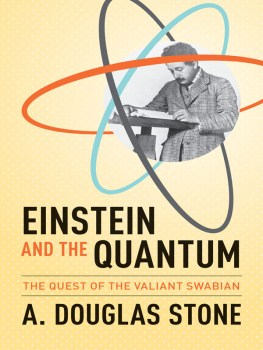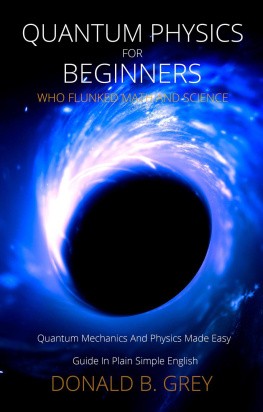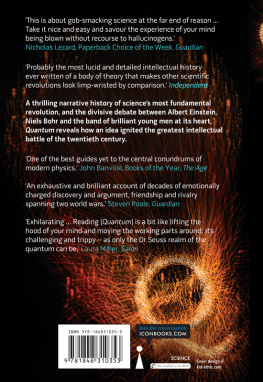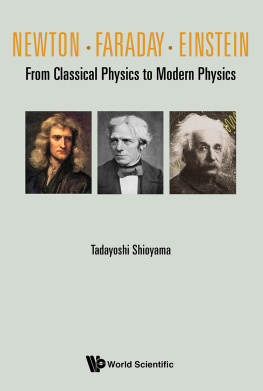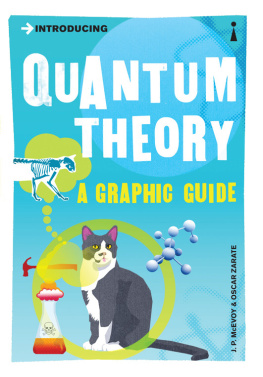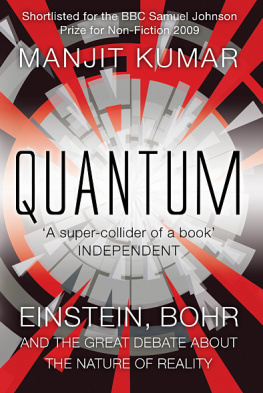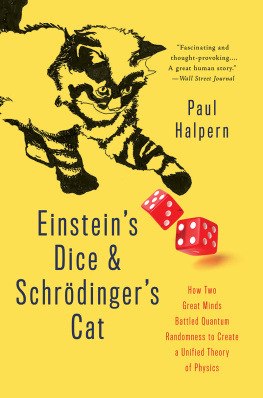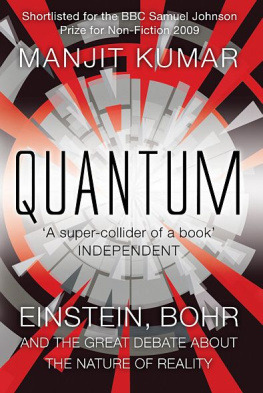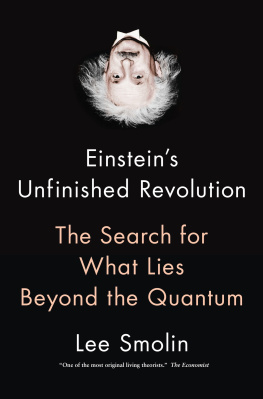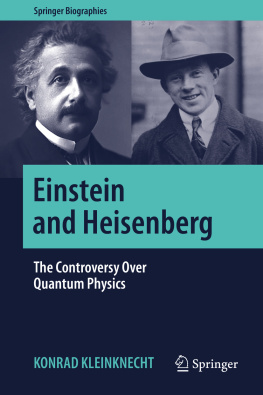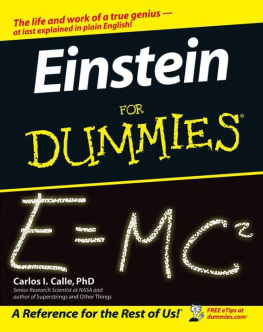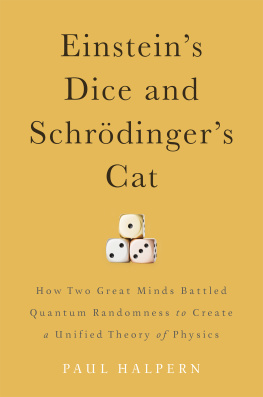
EINSTEIN AND THE QUANTUM
EINSTEIN AND THE QUANTUM
THE QUEST OF THE VALIANT SWABIAN
A. DOUGLAS STONE
PRINCETON UNIVERSITY PRESS
PRINCETON AND OXFORD
Copyright 2013 by Princeton University Press
Published by Princeton University Press, 41 William Street, Princeton, New Jersey 08540
In the United Kingdom: Princeton University Press, 6 Oxford Street, Woodstock, Oxfordshire OX20 1TW
press.princeton.edu
Jacket photograph: Albert Einstein reading. Courtesy of The Hebrew University of Jerusalem / Corbis Historical Images. Personality rights of ALBERT EINSTEIN are used with permission of The Hebrew University of Jerusalem. Represented exclusively by GreenLight.
All Rights Reserved
Library of Congress Cataloging-in-Publication Data
Stone, A. Douglas, 1954
Einstein and the quantum : the quest of the valiant Swabian / A. Douglas Stone.
pages cm
Includes bibliographical references and index.
ISBN 978-0-691-13968-5 (hardback)
1. Einstein, Albert, 18791955. 2. PhysicistsBiography. 3. Quantum theory. 4. ScienceHistory. I. Title.
QC16.E5S76 2013
530.12dc23 2013013162
British Library Cataloging-in-Publication Data is available
This book has been composed in Verdigris MVB
Printed on acid-free paper.
Printed in the United States of America
10 9 8 7 6 5 4 3 2 1
This book is dedicated to my father, Alan, who has been my intellectual inspiration, and to my wife, Mary, who has been my emotional inspiration.
, already completed, is the most objective, most impersonal thing that we humans know. Science as something coming into being, as a goal, however, is just as subjectively, psychologically conditioned, as all other human endeavors.
ALBERT EINSTEIN, 1932
ACKNOWLEDGMENTS
This project began after I gave several public lectures at Aspen and at Yale on Einstein, Planck, and the beginning of quantum theory, when it became clear that most of this story was completely unknown both to the interested layman and to most working physicists. While several eminent historians of science, T. S. Kuhn, Martin Klein, Abraham Pais, and John Stachel for example, have written excellent but relatively technical works analyzing various facets of Einsteins work on quantum theory, no book for the general reader had attempted to synthesize all this into a complete picture. I have tried to fill that void with this book, while making it a fun read along the way. The book is based on the Collected Papers of Albert Einstein and the large body of outstanding historiography that has been produced on the history of quantum theory, blended with material from a number of biographies of Einstein, with a particular debt to the recent ones by Albrecht Folsing and Walter Isaacson. While I chose not to footnote quotations in the text, all their sources are identified in extensive notes at the back of the book.
I want to thank the late Martin Klein for his encouragement at the very early stages of this project, and Walter Isaacson for his generous advice and assistance, which was so important to a first-time author. I am very grateful to my editor, Ingrid Gnerlich, for her critical reading of the manuscript and useful guidance, and to Deborah Chasman, who made key suggestions for improving my initial draft. I also want to thank Samantha Hasey and Eric Henney at Princeton University Press, who helped with the final stages of preparation for publication. Barbara Wollf at the Albert Einstein Archive of the Hebrew University in Jerusalem was very generous with her advice and experience relating to the copyright permissions I was seeking, and Andy Shimp helped me navigate the library systems at Yale and retrieve difficult-to-find items. Both my father, Alan Stone, and my wife, Mary Schwab Stone, read the work with a keen eye and helped me immeasurably, not the least in keeping up my enthusiasm for the project. My son, Will Stone, found time between his journalistic pursuits to work as my editorial assistant in assembling the final version of the manuscript.
EINSTEIN AND THE QUANTUM
INTRODUCTION
A HUNDRED TIMES MORE THAN RELATIVITY THEORY
Lets see if Einstein can solve our problem. This was not an idea I had ever entertained, much less verbalized, during my previous twenty-six years doing research in quantum physics. Physicists dont read the works of the great masters of earlier generations. We learn physics from weighty textbooks in which the ideas are stated with cold-blooded logical inevitability, and the history that is mentioned is sanitized to eliminate the passions, egos, and human frailties of the great natural philosophers. After all, since physical science (we believe) is a cumulative discipline, why shouldnt we downplay or even censor the missteps and misunderstandings of our predecessors? It is daunting enough to attempt to master and then extend the most complex concepts produced by the human mind, such as the bizarre description of the atomic world provided by quantum theory. Wouldnt telling the real human history of discovery just confuse people?
Thus, while I had studied history and philosophy of science avidly as an undergraduate, I had not read a single word written by Einstein during my actual career as a research physicist. I was of course aware that Einstein had contributed to the subject of quantum physics. Even freshman physics students learn that Einstein explained the photoelectric effect and said something fundamental about the quantized nature of light. And both atomic and solid-state physics (my specialty) have specific equations of quantum theory named for Einstein. So clearly the guy did something important in the subject. But the most familiar fact about Einstein and quantum mechanics is that he just didnt like it. He refused to use the theory in its final form. And troubled by the fundamental indeterminism of quantum mechanics, he famously dismissed its worldview with the phrase God does not play dice.
Despite its esoteric-sounding name, quantum mechanics represents arguably the greatest achievement of human understanding of nature. By the end of the nineteenth century progress in physical science was stymied by the most basic problem: what are the fundamental constituents of matter, and how do they work? The existence of atoms was fairly well established, but they were clearly much too small to be observed in any direct manner. Hints were emerging from indirect probes that the microscopic world did not obey the settled laws of macroscopic Newtonian physics; but would scientists ever be able to understand and predict the properties of objects and forces so far from our everyday experience? For decades the answer was in doubt, until a theory emerged, a theory that has now withstood almost a century of tests and extensions. That theory has wrung human knowledge from the deep interior of the atomic nucleus and from the vacuum of intergalactic space. It is the theory that most physicists use every day in their work. This is the theory that Einstein rejected. Thus most physicists think of Einstein as playing a significant but still secondary role in this intellectual triumph.
I might have continued with this conventional view of Einstein and quantum physics for my entire career, if not for a coincidental intersection of my own research with that of the great man. I am interested in quantum systems, which if they were not microscopic but were scaled up in size to everyday proportions, would behave chaotically. In physics this is a technical term; it means that very small differences in the initial state of a system lead to large differences in the final state, similar to the way a pencil, momentarily balanced on its point, will fall to the left or right when nudged by the smallest puff of air. I was searching (with one of my PhD students) for a good explanation of the difficulty that arises when mixing this sort of unstable situation with quantum theory. I recalled hearing that Einstein had written something related to this in 1917 and, almost as a lark, I suggested that we see if this work were relevant to our task.
Next page
